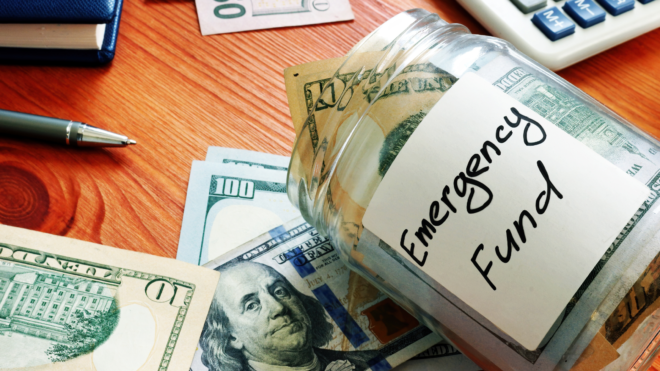Life is full of surprises. Some are pleasant, but some can negatively affect your retirement lifestyle. Here’s how to protect your nest egg and plan for whatever life throws your way.
Emergency home repairs, divorce, sudden medical expenses– these unforeseen incidents can wreak havoc on your financial stability, especially if you’re unprepared.
At CKS Summit Group, we firmly believe in having a solid plan and emergency fund to deal with unexpected expenses. In this blog, we guide you through creating, growing, and maintaining this critical financial resource. Here’s what you should know.
What is an Emergency Fund?
An emergency fund is a financial buffer, a reserve set aside to cover unanticipated costs that might otherwise throw your financial life into disarray. It is an essential part of your financial portfolio and a critical step toward financial stability.
Without an emergency fund, you might need to rely on your retirement savings, credit cards or loans to cover unexpected costs, leading to a cycle of debt that can be difficult to break. An emergency fund can provide the financial security you need to tackle unforeseen expenses head-on. Let’s take a deeper look at some helpful tips that can help you grow and maintain your emergency fund.
Determining the Size of Your Emergency Fund
There’s no one-size-fits-all answer to how large your emergency fund should be. A general rule of thumb is to aim for an emergency fund covering three to six months’ living expenses. However, since inflation and market volatility has become a prevalent factor in our day-to-day lives, experts now recommend 6-12 months of expenses. When calculating your living expenses, consider all the essential outgoings:
- Rent or mortgage.
- Utilities.
- Groceries.
- Healthcare.
- Transportation.
- Any other necessary monthly costs.
Expanding on the importance of having an emergency fund, it serves as a financial safety net to protect individuals and families from unexpected events or emergencies that could disrupt their regular income or incur significant expenses. Let’s look at key points to help you build your emergency fund.
Building Your Emergency Fund
Building an emergency fund isn’t something that happens overnight. It requires a plan and a commitment to that plan. Here are some steps you can take:
- Set a Monthly Savings Goal: Once you’ve calculated your desired emergency fund size, break it into manageable monthly savings goals.
- Budget for It: Include your monthly savings goal in your budget. If it helps, consider this as paying a bill to your future self.
- Automate Your Savings: Consider setting up an automatic monthly transfer from your checking to your savings account. This strategy removes the temptation to spend what you should be saving.
- Start Small, if Necessary: Even if you can only afford to put aside a small amount initially, it’s still a step in the right direction. Small contributions can add up over time.
- Use Windfalls Wisely: If you receive an unexpected sum, such as a tax refund or a bonus, consider directing a portion towards your emergency fund.
Once you have a better understanding of how and what your emergency fund should be used for, you can decide where you want to keep it.
Where to Keep Your Emergency Fund
Your emergency fund should be readily accessible but not so accessible that you’re tempted to dip into it for non-emergency expenses. Consider keeping it in a high-yield savings account, allowing your money to grow while remaining available when needed.
A high-yield savings account is a popular and practical option for an emergency fund. These accounts typically offer higher interest rates compared to traditional savings accounts. While the interest earned may not be substantial, letting your money grow faster than in a regular savings account is still beneficial. This growth can offset the impact of inflation over time.
If you opt to keep your emergency fund in a bank, ensure that the institution is insured by FDIC (Federal Deposit Insurance Corporation) or NCUA (National Credit Union Administration). This government-backed insurance protects your deposits up to a specific limit, typically $250,000 per account holder per institution. This protects you in case the bank or credit union faces financial trouble. It’s crucial to remember that an emergency fund is not an investment – it’s insurance.
Maintaining Your Emergency Fund
Your work isn’t over once you’ve achieved your emergency fund goal. Once your account is established, you will want to revisit and reevaluate it periodically. As years pass, the cost of living can increase due to inflation. What was enough to cover your expenses a few years ago may be insufficient today.
If your living expenses increase, your emergency fund should increase proportionally. Life is unpredictable, and there may be times when you need to use your emergency fund. If you use it, remember to replenish it as soon as possible. It might take time, especially if you’ve had to use a substantial amount, but it’s crucial to prioritize rebuilding the fund to the required level.
How CKS Summit Group Can Help
While no one can predict the future, one of the first things our financial advisors do at CKS Summit Group is to understand your financial situation, needs, and goals. Every individual is different, and so should their financial and retirement plans. We consider factors like your income, living expenses, and financial obligations to determine how much you need in your emergency fund. This approach helps us set a realistic and achievable savings goal that doesn’t strain your finances.
Once we have set a goal, the next step is to devise a savings and investment strategies. Our team helps break down your larger goal into smaller, more manageable monthly saving targets. We strive to make your money work for you, even when it’s on standby for emergencies.
Lastly, regularly reviewing and adjusting your emergency fund is crucial to reflect these changes. As your trusted financial advisor, we continually reassess your emergency fund strategy to ensure it aligns with your current circumstances and long-term financial goals. For more information on our service offerings, see here.
Final Thoughts
Building and maintaining an emergency fund is fundamental to ensuring financial stability and peace of mind. With careful planning and discipline, you can fortify your financial future against unexpected expenses, allowing yourself to focus on your long-term financial goals for a worry-free retirement.
At CKS Summit Group, we aim to provide you with financial peace of mind so you can focus on making the most of your retirement. We believe in preparing for every financial situation, regardless of the emergency.
Contact us today to schedule a consultation and learn more about how we can help.



